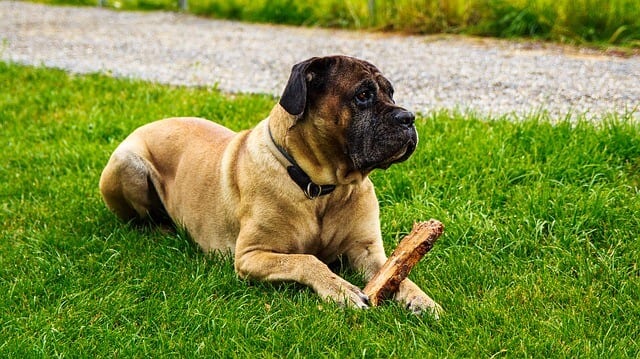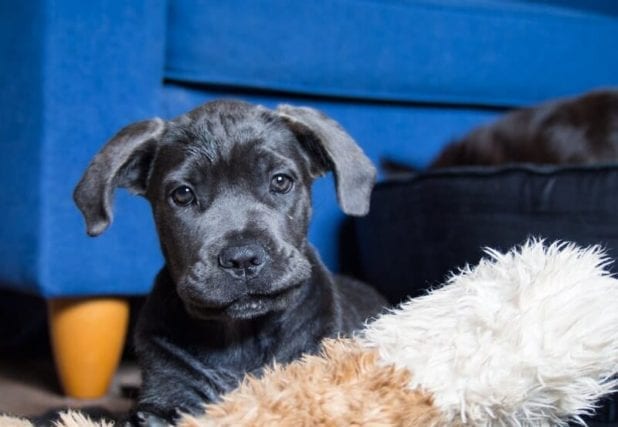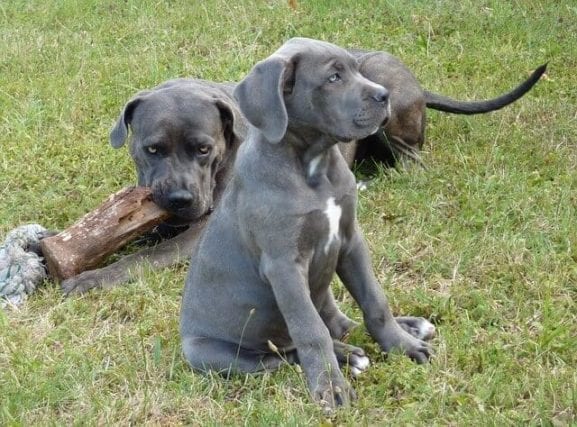The Cane Corso Azul or Cane Corso Blue is a product of the dilution of the black color, so the Cane Corso blue can be solid gray or brindle blue. They are not a separate race, this distinction is used to differentiate them into groups.
Modern representatives of this breed are characterized by an antique appearance, which has been restored by dog handlers. The color of the Cane Corso can be different, but most often it is black.
Blue Cane Corso is also called gray since the tone of this color can vary from light gray (blue) to slate gray or asphalt.
Discover the facets about this splendid animal along with its best qualities, we will adequately illustrate how you should take care of it from when it arrives at your home until adulthood, follow us and discover more about this incredible guard dog.
History of the breed
Cane Corso is the heir to the ancient Tibetan Great Danes or Molossians. When the descendants of the Molossians arrived in the Roman Empire, they began to be used in military campaigns, in arena battles, and to protect territories.
In ancient annals, the Cane Corso is characterized as tireless, fearless, and loyal dogs.
The official countdown of the history of the Cane Corso begins from the time of the active prosperity of the Roman Empire, but when this empire fell, the new aristocracy did not keep the Cane Corso in their yards.
As a result, the breed began to mix with others and was on the verge of extinction.
In the 70s of the last century, interest in the breed reawakened, and in the 80s canine handlers compiled the official breed standard, which was positively evaluated by experts in 1994.
Currently, the Cane Corso is a very popular breed, the demand for which is constantly on the rise
Cana Cros Standard Breed Colors & Genetics

1. Black
Entirely black subjects ( a small white patch on the chest, toes, and bridge of the nose is allowed ). If there is at least one tawny hair in the dog’s body, this dog is not genetically black. The black color is determined by a combination of Ay-BD-Em-K- alleles.
The sign (-) indicates that the subject at that locus can be both homozygous and heterozygous and that heterozygosity is not influential for the phenotypic manifestation of color as the allele is dominant. Black dogs always have well pigmented black lips, nose, and eyelids, as well as possibly the palate and plantar pads.
However, a black subject can carry in its recessive genetic repository the variants of the genes which, in certain combinations together with the variants of the partner’s genes, can give birth to dogs of all other colors (even unwanted).
This is an example of the birth of a gray puppy from two black parents:
By mating Ay-B-DdEm-K- (black) X Ay-B-DdEm-K- (black)
we get:
Ay-B-DDEm-K- (black puppy)
Ay-B-DdEm-K- (black puppy)
Ay-B-ddEm-K- (gray puppy with gray lips, nose, and eyelids
If a gray puppy was born from two black dogs we can say with certainty that both parents are heterozygous for the locus (D) and the puppy is instead homozygous for the recessive gene dd

2. Gray
The colors of the standard lead-gray, slate gray, light gray are genetically one color, ie gray of varying degrees of intensity. The gray color is essentially a diluted black determined by the presence of a recessive dd homozygote in combination with B- and K- alleles.
The genetic formula of color can be written as: Ay-B-ddEm-K-
The presence of a pair of dd alleles in a genotype dilutes not only the color of the hair from black to gray but also always obligatorily the pigmentation of the lips, of the nose and eyelids – which also take on shades of gray, more or less intense.
All puppies that are born from mates between two gray dogs are therefore homozygous recessive dd. Consequently, it is certain that from two gray dogs only puppies with accepted colors of the diluted type can be born (gray, gray brindle, fawn with gray mask) but also puppies with unwanted colors and not accepted in the standard can be born – gray and tan, gray tan with stripes.
The manifestation of a particular color in offspring depends on which of the gene variants on other locus (except D) the pups will have from the combination of alleles of the parents.
– By coupling Ay-B-ddEm-Kk (gray) X Ay-B-ddEm-KK (gray)
we obtain:
Ay-B-ddEm-KK (gray)
Ay-B-ddEm-Kk (gray)
While coupling Ay- B-ddEm-Kkbr (gray) X Ay-B-ddEm-Kkbr (gray)
we obtain: Ay-B-ddEm-KK (gray)
Ay-B-ddEm-Kkbr (gray)
Ay-B-ddEm-kbrkbr (gray brindle)

3. Fawn with a mask.
The fawn color in the Cane Corso breed strikes the imagination for its many variables: light fawn, fawn, deer fawn, dark fawn, and all the shades in between. The intensity of the fawn color depends on the action of special genes called polygenes Rufus by the geneticist Robinson.
The tawny colors entered in the standard are determined by a combination of Ay- and kk alleles. The kk homozygote gives a chance to the fawn color to manifest itself in the phenotype, and the presence of the Ay- allele, in turn, characterizes the color of the fawn hair with the darker terminal part.
The intensity of this dark terminal zone always depends on the action of modifier genes. It goes from a diffuse and deep action (visible as carbonations on the coat) up to a very light, minimal action, almost invisible to the human eye (light fawn).
It’s therefore evident that the difference between a fawn with a black mask and a fawn with a black mask and charcoal on the body is exclusively dependent on the force with which the modifiers act. From the point of view of the genes contained in the loci, the two subjects are identical.
The mechanisms of action of the modifiers have not yet been fully clarified, therefore, a selection that tends to exclude carbonate subjects first and second the relatives of the carbonate subjects, is mainly based on non-compliance with the standard of the former and on the attempt to reduce the risks in future generations for the latter.
But on a genetic level, two carbonated subjects can reproduce puppies with an admitted and correct fawn color as well as two correct fawn subjects can reproduce carbonated sons. It should also be well specified that reproducing a fawn subject without a mask is much more serious than having a fawn subject reproduce, as the carbonate is genetically a fawn with a mask and therefore must be included among the colors allowed by the standard although with a serious defect.
All fawn subjects must have a mask that does not exceed the line of the eyes. Depending on the color of the mask we can divide the group of fawn colors into two subgroups: fawn with black mask and fawn with a gray mask.
a) Fawn with a black mask.
The genetic formula is Ay-BD-Em-kk
Lo are all subjects of any intensity of fawn color, with a black mask on the muzzle and with well pigmented black lips, eyelids, and nose.
b) Fawn with a gray mask (formentino).
The genetic formula is Ay-B-ddEm-kk.
All fawn-colored subjects of any intensity with a gray mask on the face are the presence of a pair of dd alleles weakens the black to gray, therefore the terminal part of the hair, towards the tip, is darker than the base but due to the presence of the Ay allele, the hair becomes gray from black.
Dogs of this color always have gray lips, eyelids, and nose.
From the mating of two fawn dogs, all their puppies will receive a pair of kk alleles, which determines a fawn color in the phenotype.
Coupling Ay-BD-Em-kk (fawn with black mask) X Ay-B-ddEm-kk (fawn with gray m)
we obtain:
Ay-B-DdEm-kk (fawn with black mask)
Ay-B-ddEm- kk (fawn with gray mask)
–B-Ddeekk (e-fawn recessive (fawn without mask) – color not accepted).
This is an example of how gray or fawn puppies with a gray mask can be born from the coupling between a black subject and a fawn subject with a black mask: by
mating Ay-B-Dd-Em-Kk- (black) X Ay-B -Dd -Em-kk (fawn with black mask)
we obtain:
Ay-BD-EmKk (black),
Ay-BD-Emkk (fawn with black mask),
Ay-B-ddEm-K- (gray),
Ay- B-ddEm -kk (fawn with gray mask)
With this example, it is clear how the birth of a fawn puppy with a gray mask from two parents, one fawn and the other black is possible only if both parents are heterozygous Dd, and the black parent should also be heterozygous Kk.

4. Brindle
The brindle color is determined by the presence of the kbr allele.
In the phenotype, it manifests itself with black or gray stripes on the coat which has a fawn background. The shape, width, frequency, and position of the stripes depend on the action of multiple modifier genes.
All brindle dogs must have a mask on the face, colored in relation to the tone of the black or gray stripes. The group of brindle colors can be divided into two subgroups: brindle and gray brindle.
a) Brindle
The genetic formula is Ay-BD-Em-kbr-
All the subjects with black stripes of different widths on a tawny background of different intensity are so:
from thin black stripes on almost entirely tawny dogs up to almost totally black subjects with single and well separated tawny streaks (color commonly called brindle black). The brindle dogs have a black mask on the muzzle and must be well pigmented in black on the lips, on the eyelids and on the nose.
b) Gray Brindle
The genetic formula is Ay-B-ddEm-kbr-
The presence of a pair of dd alleles weakens the black and makes it appear gray.
Dogs of this color have gray streaks of varying widths on a fawn background of any intensity (from light fawn to dark fawn). They have a gray mask on the muzzle. Lips, eyelids and nose are also gray.
From mating between two brindle dogs, it is impossible to have black or gray puppies.
The intensity, quantity, and position of the parents’ stripes are absolutely irrelevant. If there is even minimal branding in both parents, no black or gray puppies will be born. There have been cases of puppies declared as black and offspring of two brindle dogs. They also received the pedigree stating that these subjects were black in color.
This is logically incorrect, as these puppies cannot be genetically black. The appearance of an integral phenotypically black subject is given by the action of modifier genes that make black stripes so large as to completely hide the fawn.
It is possible that even minimal streaks of tawny color come out during the growth phase and were not evident at the time of the declaration of the litter, but the genetic transmissibility excludes its non-appearance.
The breeder should pay attention to these rules of transmissibility in order not to incur incorrect declarations on the color of the subjects and should take them into account when breeding these dogs.
A subject phenotypically black due to the action of modifier genes but not genotypically black, if chosen in mating for the visible color of its coat, will produce puppies that do not reflect the expectations of the breeder.
For example, let’s analyze the possibility of birth of fawn puppies with black or gray masks from a mating between a brindle subject and a brindle gray subject. Both parents must be heterozygous kbrk:
Coupling Ay-B-DdEm-kbrk (brindle) X Ay-B-ddEm-kbrk (gray brindle)
we obtain:
Ay-B-DdEm-kbr- (brindle)
Ay-B-ddEm- kbr- (gray brindle)
Ay-B-ddEm-kk (fawn with gray mask)
Ay-B-DdEm-kk (fawn with black mask)
Character and performance
The color of the coat does not affect the character of the Cane Corso and its performance qualities, it depends on the pigment melanin, which is also responsible for the color of hair and skin.
Corso is an independent dog that has a heightened sense of self-esteem. It will not tolerate an aggressive and cruel attitude towards Itself, therefore, raising a dog, the owner should not show irritation. Otherwise, the Corso will quickly understand human weakness and refuse to obey.
This intelligent and noble dog lends itself well to training, it has well-developed guarding and guarding qualities, so it will protect the owner and Its property without much training.
The Cane Corso is devoted to one family for life and it will be very sad if the owner is not around. With regard to children, the Cane Corso shows caution and frugality, so it can be adopted to families with children without fear.
Here are some disadvantages of the breed, they are as follows :
- This dog requires a lot of living space due to its size.
- This is a very active dog, so it is not recommended for lazy people – out of boredom, Corso can gnaw on shoes and furniture.
- If the dog didn’t grow up with cats around, it will perceive them as potential prey.
- A Cane Corso eats a lot.
Cane Corso is not suitable for people who are too busy and spend little time at home.
The Blue Cane Corso is a large dog with well-developed muscles. The color blue is not considered a rare color, but most often Cane Corso is black. The blue dog has a powerful chest, wide muzzle, long legs.
Despite the fact that the Cane Corso is a fighting dog breed and looks quite intimidating, it’s not devoid of charm. It’s not difficult to take care of the dog, it is very smart, caring, and affectionate. A Corso trusts its owner completely and is ready to protect It and Its family to the last breath.
Caring for a Blue Cane Corso
The Corsican dog is a relatively straightforward breed in terms of grooming requirements, its short, shiny coat should be brushed once a week with a natural bristle brush, bathing is usually necessary every two to three months, only bathe your dog if it has rolled in the dirt, the rest care includes elementary procedures such as regular nail cleaning and weekly tooth brushing, examine your pet’s ears well on a systematic basis, in order to detect early signs of infection such as redness and odor. This dog sheds heavily twice a year so it is recommended to spend more time brushing during these periods.
The Cane Corso is relatively an easy dog to train, Its sharp mind makes It a quick learner, although It’s willing to obey only that person whose has the superior position, such as a group hierarchy, make sure to keep a constant check on the situation otherwise your dog will easily figure out your weakness and may become undisciplined and stubborn.
Many experienced trainers place a high value on the breed’s talents in training, unlike most guardian breeds this dog does well in agility and obedience competitions, however, it will never endure harsh training and will react to it. It with disobey and even become aggressive, it’s much wiser to stimulate the interest of the dog with Its favorite food and generous praise.
The Cane Corso is very demanding at the level of its physical activity, for better health very long and vigorous walks are absolutely essential, although it certainly prefers to have a daily opportunity to roam and play in a closed territory safely, Its energetic nature and great toughness also make it a wonderful companion for runners and hikers, remember that the Italian Cane Corso has to let off steam on a regular basis, otherwise it will develop problems of aggressiveness, destructiveness, and excessive barking.
The Blue Cane Corso Qualities
- They are skilled, tenacious, independent, and even territorial.
- The Cane Corso is very smart; however, it can be somewhat overbearing.
- It’s not an aggressive dog with proper training.
- They are docile and affectionate with their entire family, including children.
- It’s a dog characterized by being loving, faithful, and very protective.
These are the qualities that distinguish this good canine, we must emphasize that the Cane Corso also needs mental stimulation in addition to physical activity. For example, if you could take It to a farm where It has cattle, it would be a good way to stimulate Its mental activity.

Blue Cane Cros and Grooming
Grooming begins with brushing the canine and is quite easy due to its short coat, although its large size implies a great effort, but don’t worry, it will be more entertaining than you think.
Brushing Its coat can be done with a natural bristle brush or glove once a week. Additionally, we can apply a conditioner to give more shine to Its hair. You should bathe It every three months or when it is too dirty, but only with a mild special shampoo.
Other basic care that we must give are the following:
- Check Its ears every week and clean them if necessary.
- Trim its toenails regularly, usually once a month.
- Brush Its teeth regularly with a soft toothbrush and dog toothpaste.
These steps must always be done at an early age so that the dog can get used to grooming, in this way It will accept it more easily in the adult stage.
Finally, we recommend that you know how to make the most of your Cane Corso’s abilities, either as a companion or as a guard dog.


